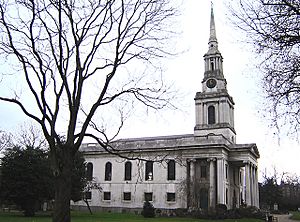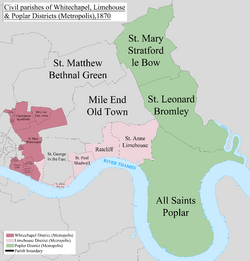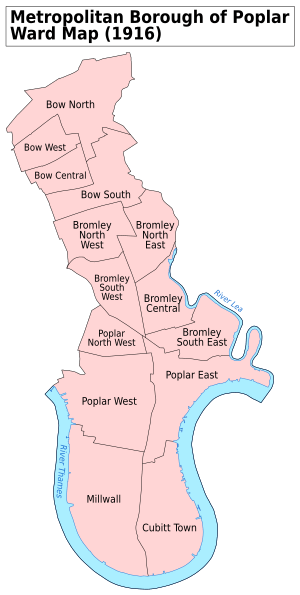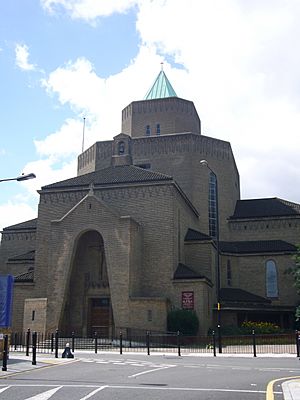Poplar, London facts for kids
Quick facts for kids Poplar |
|
|---|---|
 All Saints Church, Poplar |
|
| OS grid reference | TQ375805 |
| • Charing Cross | 5.5 mi (8.9 km) W |
| London borough | |
| Ceremonial county | Greater London |
| Region | |
| Country | England |
| Sovereign state | United Kingdom |
| Post town | LONDON |
| Postcode district | E14 |
| Dialling code | 020 |
| Police | Metropolitan |
| Fire | London |
| Ambulance | London |
| EU Parliament | London |
| UK Parliament |
|
| London Assembly | |
Poplar is a lively area in East London, England. It is part of the London Borough of Tower Hamlets. Poplar is about five miles (8 km) east of Charing Cross. It sits near the River Lea and is part of the London Docklands area.
Poplar is known as an important local hub in London. Its main shopping area is Chrisp Street Market. This market is a busy place for shops and businesses. It is surrounded by many homes.
Poplar was once part of a larger area called Stepney. By the 1600s, it became a more independent "Hamlet." In 1817, it became its own parish. Later, it was known as the Metropolitan Borough of Poplar. In 1965, Poplar joined with other areas to form the London Borough of Tower Hamlets.
Contents
Poplar's Story: A Look Back in Time
How Poplar Started and Grew
Poplar was first mentioned around 1327 or 1350. Its name comes from the Black Poplar trees. These rare, large trees used to grow well here. They liked the wet ground near the River Thames and River Lea. One of these trees was still growing in the area in 1986.
By the 1600s, Poplar was a "Hamlet." This was a small part of Stepney, but it had some independence. In 1817, the Hamlet of Poplar became its own parish. This meant it could manage its own local affairs.
Poplar was part of the historic county of Middlesex. However, many local duties were handled by the Tower Division. This group was also called the Tower Hamlets.
The Tower Division's role ended in 1889. That is when Poplar became part of the new County of London. In 1965, the County of London was replaced by Greater London.
In 1855, Poplar joined with nearby Bromley and Bow. They formed the Poplar District. This district became the Metropolitan Borough of Poplar in 1900. Its population was 168,822 in 1901. In 1965, it merged with other boroughs. These were Stepney and Bethnal Green. Together, they formed the new London Borough of Tower Hamlets.
Life and Work in Poplar's Past
In 1654, Poplar's population began to grow. The East India Company gave land to build a church. This church became the center of the growing community. St Matthias Old Church is on Poplar High Street. It is across from Tower Hamlets College.
Shipbuilding was a big industry in Poplar from the 1400s. Maritime jobs became even more important after 1806. That is when the East and West India Docks opened. Thames Ironworks was a major employer until 1912. Its workers' football team became West Ham United F.C.. The docks were heavily bombed during The Blitz in World War II.
In 1921, the Metropolitan Borough of Poplar saw the Poplar Rates Rebellion. This was led by Mayor George Lansbury. He later became the leader of the Labour Party. In 1951, a new housing area was built. It was named the Lansbury Estate after him. This estate includes Chrisp Street Market.
Other famous buildings were also built here. These include the Robin Hood Gardens housing complex. It was designed by architects Peter and Alison Smithson. The brutalist Balfron Tower, Carradale House, and Glenkerry House were designed by Ernő Goldfinger. Poplar Baths also closed in 1989. It reopened in 2016 after local people worked hard to save it.
Many people from other countries came to Poplar for maritime jobs. This included the Chinese community in the Pennyfields area. This area was part of the old East End Chinatown.
The West India Dock and other local docks closed by 1980. The British Government then decided to rebuild the docklands. They created the London Docklands Development Corporation (LDDC) in 1981. The Isle of Dogs also became an Urban Enterprise Zone in 1982.
In 1998, residents voted to transfer some council homes. Parts of the Lansbury estate and six other housing estates moved to Poplar HARCA. This was a new housing association. It was set up to improve the area. Later, more estates in Poplar joined Poplar HARCA and other landlords. This happened between 2005 and 2007.
Poplar During Wartime Bombings
The first air attacks in Britain happened during World War I. These caused much damage and many deaths. German raids killed 1,413 people and injured 3,409. Air raids were a new way to attack an enemy's war effort. Many things from these raids, like blackouts and air raid warnings, became common in World War II.
East London was a main target. Poplar was hit hard by air raids in World War I. At first, Zeppelins bombed the area at night. This caused the deaths of many innocent people.
The first daytime bombing of London by a plane was on June 13, 1917. Fourteen German Gotha G.IV bombers dropped bombs. Many bombs fell quickly in different areas. In the East End, 104 people died. Another 154 were seriously hurt, and 269 had minor injuries.
The worst event that day was a direct hit on a school in Poplar. The Upper North Street School was hit. A bomb fell through the roof into the girls' class. It then fell through the boys' classroom. Finally, it exploded in the infant class. Eighteen students were killed. Sixteen of them were only 4 to 6 years old. This tragedy deeply shocked the British public.
In World War II, Poplar suffered greatly during the Blitz. The borough lost 770 civilians due to enemy attacks. During the heaviest bombing, ten Poplar schools were moved to Oxford for safety.
Buildings and Places in Poplar
Poplar's buildings are a mix of old and new. You can see 18th and 19th-century terraced houses. There are also 20th-century council estates. Famous examples include the Lansbury Estate and the Balfron Tower.
A new Church Green was made in 2012. It is next to St. Mary and St. Joseph Church. This spot was once a Catholic church bombed during The Blitz. The new green has public art. This includes a statue for dockers and sailors. There is also a 15-foot crucifix and a modern sculpture called A Doorway of Hope.
Poplar High Street has many important landmarks. It used to be the main street in Poplar. These include the old Poplar Town Hall. It has beautiful mosaic details and is now a hotel. Poplar Bowls Club started in 1910. It is part of Poplar Recreation Ground. A sports center called The Workhouse recently reopened. It is on the site of the old Poplar Workhouse. Local politician Will Crooks spent his early years there. The Grade II* listed St Matthias Old Church is also on the High Street. It was built by the British East India Company in 1654. Now it is a community center.
The first Poplar Baths opened in 1852. It cost £10,000 to build. It provided public washing places for poor people in the East End. This was due to the Baths and Washhouses Act 1846. The Baths were rebuilt in 1933. The larger pool was covered to make it a theater. It was called the East India Hall. Poplar Baths reopened in 1947 after World War II. It was used for swimming until 1988. Then it became a training center. The Baths reopened again on July 25, 2016.
The Museum of London Docklands opened in 2003. It is at West India Quay. It is in an old sugar warehouse built in 1802. This building is a grade I listed example of Georgian architecture.
Poplar's Industries
Poplar is still part of the Port of London. Northumberland Wharf is still a working wharf. It has special status from the Mayor of London and the Port of London Authority (PLA). It is run by Cory Riverside Energy. They also manage a recycling center next to the wharf. They use barges to move waste along the River Thames.
Poplar Borough Council was allowed to supply electricity in 1893. Electricity started flowing in October 1900. It came from a power station on Glaucus Street. This station was later called Poplar Watts Grove. The power station used water from the nearby Limehouse Cut canal. It also used cooling towers to make steam into water and for cooling.
The power station closed in 1967.
Learning in Poplar
Langdon Park School is a mixed secondary school and sixth form. It is northeast of Chrisp Street Market.
The George Green's School was started in 1828. It was founded by George Green, a shipbuilder. It was first on East India Dock Road. Today, it is a school supported by the Worshipful Company of Shipwrights. It is located on the Isle of Dogs peninsula.
Getting Around Poplar
 |
Dalston Shoreditch |
Hackney Mile End |
Stratford Bow |
 |
| Brick Lane Aldgate Stepney |
(River Lea) Three Mills |
|||
| Limehouse Tower Gateway Bank |
Isle of Dogs Canary Wharf (River Thames) |
(River Lea) Canning Town |
Trains and Underground
Poplar is connected by the Docklands Light Railway (DLR). Five DLR stations serve the area. These are All Saints, Langdon Park, Poplar, Blackwall, and East India. These stations are in London fare zone 2. They link Poplar to places like Bank, Canary Wharf, City Airport, Greenwich, and Stratford.
Poplar DLR station is a key point for the DLR network. Many different routes meet there.
The closest London Underground station is Canary Wharf. You can catch Elizabeth line and Jubilee line trains there.
The nearest National Rail station is Limehouse. c2c trains stop there. They go between London Fenchurch Street and places in South Essex, like Southend Central.
Buses
Several London Buses routes serve Poplar. These include routes 15, 115, 309, and D6. Night bus routes N15 and N551 also run here.
Roads
Poplar has good road links to East London and East Anglia.
- The A12 runs along Poplar's eastern edge. It goes north towards Stratford and Hackney Wick. It continues to the M11, Romford, and Chelmsford. Its southern end is in Poplar.
- The A13 (East India Dock Road) goes through the center of Poplar. Westbound, it links to Limehouse, Aldgate, and the city. Eastbound, it goes towards Canning Town, Barking, Tilbury, and Southend-on-Sea.
- The A102 (Blackwall Tunnel) starts on Poplar's eastern side. It goes under the River Thames. It leads to the Greenwich Peninsula, the A2, and south-east London.
- The A1206 (Cotton Street) runs from the A13 through eastern Poplar. South of Aspen Way, it goes around the Isle of Dogs. It connects Poplar to Canary Wharf and Millwall.
- The A1261 (Aspen Way) runs along Poplar's southern edge. It separates Poplar from Canary Wharf. Aspen Way goes east towards the Limehouse Link and the A13. Westbound, it goes to Blackwall, the A13, and the A1020. This road leads to the ExCeL and City Airport.
Poplar High Street runs through the middle of Poplar.
Cycling
The Cycle Superhighway 3 (CS3) goes through Poplar from east to west. It follows Poplar High Street. This route is clear and signposted. Westbound, it goes towards Lancaster Gate (Hyde Park). Eastbound, cyclists leave Poplar on Naval Row. They follow signs towards Canning Town and the A13. The route runs next to the A13 towards Canning Town, East Ham, and Barking.
National Cycle Route 13 also follows the CS3 route through Poplar. This long-distance route connects Tower Hill to Fakenham, Norfolk. East of Poplar, this route goes non-stop as far as Purfleet.
Poplar in Movies, TV, and Art
Balfron Tower has been seen in many music videos, films, and TV shows. Other places in Poplar have also been used. According to IMDb, Poplar locations have been in these movies:
- 1984 (1956)
- To Sir, With Love (1967)
- A Fish Called Wanda (1988)
- Return of Spinal Tap (1992; Coldharbour)
- The World Is Not Enough (1999)
- The Da Vinci Code (2003)
- 28 Days Later (2002; Woodstock Terrace and Balfron Tower)
Films
- The documentary film Fly a Flag for Poplar (1974) shows Poplar and its people. It looks at their daily lives and local festivals. The film also highlights the Labour movement's importance in the early 1900s. It shows the big strikes and events of 1921 when the Poplar Council members went to prison.
- A documentary about Chrisp Street Market, E14: A Dying Trade, was filmed in 2011.
Television
- The BBC One TV series, Call the Midwife, is set in Poplar. It shows life in the late 1950s through 1968.
Art
- The AB Foundry is in Poplar. It has worked with famous artists like Anthony Gormley, Henry Moore, Gavin Turk, Rachel Whiteread, and Barry Flanagan.
- The Poplar Union was built as an art center. It is now home to e5 Roasthouse. It supports the local community through art, culture, and wellness. It offers family activities, comedy, music, dance, and health classes.
- Poplar has some notable street art. You can find it especially around the Chrisp Street Market area. Artists like Above, Malarky, Cawaiikawaii, Lilly Lou, and Gary Stranger have created work there. Irony and Boe painted a giant chihuahua near All Saints DLR station. There is also a small work by Banksy nearby.
- Many famous artists have lived in Poplar. These include Michael Green, Ian Berry, Elizabeth Fritsch and Stuart Semple. They lived and worked in the Spratt's Complex. In 2014, many artists moved into spaces at Balfron Tower.
Famous People From Poplar
- Teddy Baldock: A boxer known as "The Pride of Poplar." He was the Commonwealth Boxing Bantamweight Champion from 1928–30.
- Neil Banfield: A coach at Arsenal F.C..
- Will Crooks: A politician and social reformer. He was the first Labour mayor in London. A housing estate on Poplar High Street is named after him.
- Alfie Doughty: A footballer for Luton Town.
- Tommy Flowers: He designed the first programmable electronic computer. It was used for code-breaking at Bletchley Park. He was born at 160 Abbott Road.
- Alfred Hitchcock: A famous film director. He lived in Salmon Lane as a child. His family had a fishmongers there.
- Sir Nicholas de Loveyne: He owned the manor of Poplar. He made his will there in 1375, just before he died.
- Charlie Magri: A world champion flyweight boxer. He grew up on the Burdett Estate.
- Arthur Morrison: An author and journalist.
- John McDougall: A politician who represented Poplar from 1889 to 1913. A small park near Millwall Dock is named after him.
- John Mucknell: Known as "The King's Pirate." He was born in 1608 and lived in Poplar after he married.
- Harry Redknapp: A well-known football manager.
- Richard Spratly: He discovered the Spratly Islands in 1843.
- H. M. Tomlinson: A travel writer, journalist, and author of The Sea and the Jungle (1912).
- Jennifer Worth: The author of Call the Midwife.
- Rip: A search and rescue dog who received the Dicken Medal.
Images for kids
See also
 In Spanish: Poplar (Londres) para niños
In Spanish: Poplar (Londres) para niños






